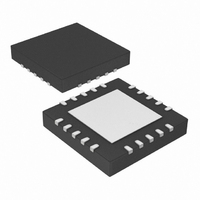PIC24F16KA101T-I/MQ Microchip Technology, PIC24F16KA101T-I/MQ Datasheet - Page 27

PIC24F16KA101T-I/MQ
Manufacturer Part Number
PIC24F16KA101T-I/MQ
Description
16KB Flash, 2KB RAM, 512B EEPROM, 16 MIPS, 16 I/O,16-bit PIC24F Family, NanoWatt
Manufacturer
Microchip Technology
Series
PIC® XLP™ 24Fr
Datasheets
1.MA240017.pdf
(254 pages)
2.PIC24F04KA201-ISS.pdf
(48 pages)
3.PIC24F16KA101-ISS.pdf
(18 pages)
Specifications of PIC24F16KA101T-I/MQ
Core Processor
PIC
Core Size
16-Bit
Speed
32MHz
Connectivity
I²C, IrDA, SPI, UART/USART
Peripherals
Brown-out Detect/Reset, POR, PWM, WDT
Number Of I /o
18
Program Memory Size
16KB (5.5K x 24)
Program Memory Type
FLASH
Eeprom Size
512 x 8
Ram Size
1.5K x 8
Voltage - Supply (vcc/vdd)
1.8 V ~ 3.6 V
Data Converters
A/D 9x10b
Oscillator Type
Internal
Operating Temperature
-40°C ~ 85°C
Package / Case
20-VQFN
Lead Free Status / RoHS Status
Lead free / RoHS Compliant
Available stocks
Company
Part Number
Manufacturer
Quantity
Price
Part Number:
PIC24F16KA101T-I/MQ
Manufacturer:
MICROCHIP/微芯
Quantity:
20 000
FIGURE 4-6:
4.7
The PIC24FXXKAXXX family has eight Configuration
registers
cleared to select various device configurations. There
are three types of Configuration bits:
• System Operation Bits
• Code-Protect Bits
• Device ID Bits
Table 4-2 provides the Configuration registers.
© 2008 Microchip Technology Inc.
These bits determine the power-on settings for
system-level components, such as the oscillator and
Watchdog Timer.
These bits prevent program memory from being read
and written.
These are read-only bits, which are located from
FF0000 to FF0003, and are unique to every device.
BaseAddress + 02h
BaseAddress =
.
Configuration Bits Programming
The bits of these registers can be set or
No
RemainingWords = 256 (100h)
Command to Program
RemainingWords – 1
FLOWCHART FOR
PROGRAMMING DATA
EEPROM
RemainingWords =
BaseAddress = 0
RemainingWords
PROGD response
BaseAddress
Send PROGD
PASS?
Finish
Start
Are
‘0’?
Is
Yes
Yes
Report Error
Failure
No
Advance Information
4.7.1
Configuration bits may be programmed, a single byte at
a time, using the PROGP command. This command
specifies the configuration data and Configuration
register
programmed, any unimplemented or reserved bits
must be programmed with a ‘1’.
Eight PROGP commands are required to program the
Configuration bits. Figure 4-7 illustrates the flowchart
for Configuration bit programming.
4.7.2
After the Configuration bits are programmed, the
contents of memory should be verified to ensure that
the programming was successful. Verification requires
the Configuration bits to be read back and compared
against the copy held in the programmer‘s buffer. The
READP command reads back the programmed
Configuration bits and verifies that the programming
was successful.
Note:
PIC24FXXKAXXX
address.
Configuration bits.
PROGRAMMING METHODOLOGY
If the General Segment Code-Protect bit
(GCP) is programmed to ‘0‘, code memory
is code-protected and cannot be read. Code
memory must be verified before enabling
code
“Code-Protect Configuration Bits” for
more
PROGRAMMING VERIFICATION
protection.
information
When
Configuration
See
on
DS39919A-page 27
Section 4.7.3
code-protect
bits
are












